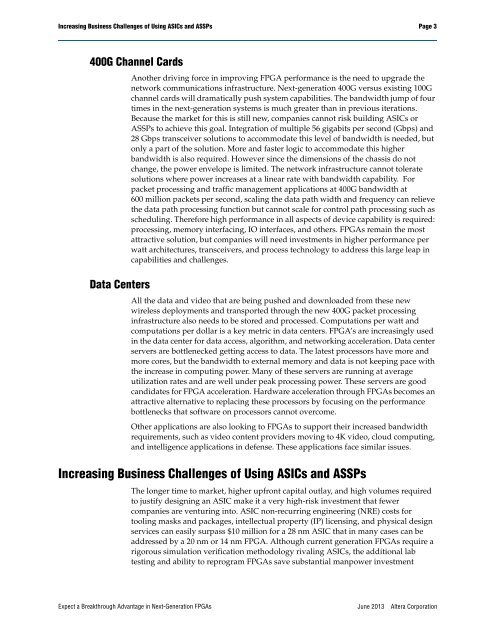Expect a Breakthrough Advantage in Next-Generation FPGAs - Altera
Expect a Breakthrough Advantage in Next-Generation FPGAs - Altera
Expect a Breakthrough Advantage in Next-Generation FPGAs - Altera
You also want an ePaper? Increase the reach of your titles
YUMPU automatically turns print PDFs into web optimized ePapers that Google loves.
Increas<strong>in</strong>g Bus<strong>in</strong>ess Challenges of Us<strong>in</strong>g ASICs and ASSPs Page 3<br />
400G Channel Cards<br />
Data Centers<br />
Another driv<strong>in</strong>g force <strong>in</strong> improv<strong>in</strong>g FPGA performance is the need to upgrade the<br />
network communications <strong>in</strong>frastructure. <strong>Next</strong>-generation 400G versus exist<strong>in</strong>g 100G<br />
channel cards will dramatically push system capabilities. The bandwidth jump of four<br />
times <strong>in</strong> the next-generation systems is much greater than <strong>in</strong> previous iterations.<br />
Because the market for this is still new, companies cannot risk build<strong>in</strong>g ASICs or<br />
ASSPs to achieve this goal. Integration of multiple 56 gigabits per second (Gbps) and<br />
28 Gbps transceiver solutions to accommodate this level of bandwidth is needed, but<br />
only a part of the solution. More and faster logic to accommodate this higher<br />
bandwidth is also required. However s<strong>in</strong>ce the dimensions of the chassis do not<br />
change, the power envelope is limited. The network <strong>in</strong>frastructure cannot tolerate<br />
solutions where power <strong>in</strong>creases at a l<strong>in</strong>ear rate with bandwidth capability. For<br />
packet process<strong>in</strong>g and traffic management applications at 400G bandwidth at<br />
600 million packets per second, scal<strong>in</strong>g the data path width and frequency can relieve<br />
the data path process<strong>in</strong>g function but cannot scale for control path process<strong>in</strong>g such as<br />
schedul<strong>in</strong>g. Therefore high performance <strong>in</strong> all aspects of device capability is required:<br />
process<strong>in</strong>g, memory <strong>in</strong>terfac<strong>in</strong>g, IO <strong>in</strong>terfaces, and others. <strong>FPGAs</strong> rema<strong>in</strong> the most<br />
attractive solution, but companies will need <strong>in</strong>vestments <strong>in</strong> higher performance per<br />
watt architectures, transceivers, and process technology to address this large leap <strong>in</strong><br />
capabilities and challenges.<br />
All the data and video that are be<strong>in</strong>g pushed and downloaded from these new<br />
wireless deployments and transported through the new 400G packet process<strong>in</strong>g<br />
<strong>in</strong>frastructure also needs to be stored and processed. Computations per watt and<br />
computations per dollar is a key metric <strong>in</strong> data centers. FPGA’s are <strong>in</strong>creas<strong>in</strong>gly used<br />
<strong>in</strong> the data center for data access, algorithm, and network<strong>in</strong>g acceleration. Data center<br />
servers are bottlenecked gett<strong>in</strong>g access to data. The latest processors have more and<br />
more cores, but the bandwidth to external memory and data is not keep<strong>in</strong>g pace with<br />
the <strong>in</strong>crease <strong>in</strong> comput<strong>in</strong>g power. Many of these servers are runn<strong>in</strong>g at average<br />
utilization rates and are well under peak process<strong>in</strong>g power. These servers are good<br />
candidates for FPGA acceleration. Hardware acceleration through <strong>FPGAs</strong> becomes an<br />
attractive alternative to replac<strong>in</strong>g these processors by focus<strong>in</strong>g on the performance<br />
bottlenecks that software on processors cannot overcome.<br />
Other applications are also look<strong>in</strong>g to <strong>FPGAs</strong> to support their <strong>in</strong>creased bandwidth<br />
requirements, such as video content providers mov<strong>in</strong>g to 4K video, cloud comput<strong>in</strong>g,<br />
and <strong>in</strong>telligence applications <strong>in</strong> defense. These applications face similar issues.<br />
Increas<strong>in</strong>g Bus<strong>in</strong>ess Challenges of Us<strong>in</strong>g ASICs and ASSPs<br />
The longer time to market, higher upfront capital outlay, and high volumes required<br />
to justify design<strong>in</strong>g an ASIC make it a very high-risk <strong>in</strong>vestment that fewer<br />
companies are ventur<strong>in</strong>g <strong>in</strong>to. ASIC non-recurr<strong>in</strong>g eng<strong>in</strong>eer<strong>in</strong>g (NRE) costs for<br />
tool<strong>in</strong>g masks and packages, <strong>in</strong>tellectual property (IP) licens<strong>in</strong>g, and physical design<br />
services can easily surpass $10 million for a 28 nm ASIC that <strong>in</strong> many cases can be<br />
addressed by a 20 nm or 14 nm FPGA. Although current generation <strong>FPGAs</strong> require a<br />
rigorous simulation verification methodology rival<strong>in</strong>g ASICs, the additional lab<br />
test<strong>in</strong>g and ability to reprogram <strong>FPGAs</strong> save substantial manpower <strong>in</strong>vestment<br />
<strong>Expect</strong> a <strong>Breakthrough</strong> <strong>Advantage</strong> <strong>in</strong> <strong>Next</strong>-<strong>Generation</strong> <strong>FPGAs</strong><br />
June 2013<br />
<strong>Altera</strong> Corporation
















